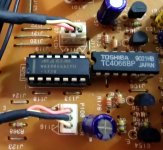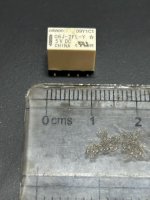I don't think that's a meaningful thing.The 4066 was never meant to be an audiophile grade device.
Take automotive grade components - they are characterized and tested for reliability in a harsh environment. If your entire device uses automotive grade components you can reach a great degree of confidence in the device reliability in that environment.
For an analog circuit handling audio the performance is all about the circuit, usually the vaguaries of individual components are finessed completely by the use of feedback, or other clever circuit topologies (matched pairs, differential signals for immunity to noise, thermal tracking of bias circuitry to output devices....). The important properties of the circuit are not determined by the components so much, with maybe noise as a clear exception.
I'm sure its possible to make a 0.0001% or lower distortion circuit using 4066's if you know what you're doing.
"The 4066 was never meant to be an audiophile grade device."
Oh really? Then why was it featured in Nakamichi's Dragon, as well as MANY of their other top decks.
Oh really? Then why was it featured in Nakamichi's Dragon, as well as MANY of their other top decks.
Watch out with such "replacements" as they don't operate over the same voltage range! The original CMOS 4066 can run up to 15V (that's +/-7.5V with a split supply), but not the others:Few things to note while using 4016/4066.
- Try to use 74HC/HCT series instead of the older CD series ICs.
- Use a power supply that is high enough to ensure adequately low distortion for analogue applications.
- Use a dual symmetric supply or alternatively center the signal about Vcc/2.
- Minimise the current through the switch to alleviate the non-linear effects.
https://www.ti.com/lit/ds/symlink/cd4066b.pdf
The "TTL" versions are (often) limited to the 5V TTL voltage range:
Operating Conditions
Supply Voltage Range, VCC
HC Types . . . . . . . . . . . . . . . . . . . . . . . . . . . . . . . . . . . .2V to 10V
HCT Types . . . . . . . . . . . . . . . . . . . . . . . . . . . . . . . . .4.5V to 5.5V
https://www.ti.com/lit/ds/symlink/cd74hct4066.pdf
The Nexperia chips have about the same operating voltages:
https://assets.nexperia.com/documents/data-sheet/74HC_HCT4066.pdf
TI has some good info on these here:
https://www.ti.com/lit/an/szza030e/szza030e.pdf
Better parts for "hifi" audio use, at several times the cost (but hey, these are still a small part of your audio system) is here from Vishay:
https://www.vishay.com/en/analog-switches/
Last edited:
Sony also used transmission gates in audio with very low distortion The problemI don't think that's a meaningful thing.
Take automotive grade components - they are characterized and tested for reliability in a harsh environment. If your entire device uses automotive grade components you can reach a great degree of confidence in the device reliability in that environment.
For an analog circuit handling audio the performance is all about the circuit, usually the vaguaries of individual components are finessed completely by the use of feedback, or other clever circuit topologies (matched pairs, differential signals for immunity to noise, thermal tracking of bias circuitry to output devices....). The important properties of the circuit are not determined by the components so much, with maybe noise as a clear exception.
I'm sure its possible to make a 0.0001% or lower distortion circuit using 4066's if you know what you're doing.
with transmission gates is the change in 'on' resistance vs signal VOLTAGE. The
'trick' is to put the transmission gate in the '-' input of an opamp such that there
is minimum Voltage across the transmission gate. This also gives a much wider
input Voltage range since what you're actually interested in is the CURRENT.
In my TV project I used an ADI transmission gate with a much lower 'on' resistance
so while the 'on' resistance changes vs signal Voltage, it's nearly 2 orders of
magnitude lower than a 4066. The ADG6412 appears to be another order of
magnitude better than the ADG1633 I used for the TV audio. For me the question
is, how good is the ADG6412 at +/- 5 V ?
G²
74HC/HCT4066 are not replacements for the CD4066. However, they're pin compatible and have more tightly regulated parameters, and that is all.Watch out with such "replacements" as they don't operate over the same voltage range! The original CMOS 4066 can run up to 15V (that's +/-7.5V with a split supply), but not the others....
Maybe was this one? The MAX4066? 45Ω 0.03%. I used it to replace the old 4066 in my Onkyo cassette deck and it made a perceptible difference. Runs at 16.75V across rails there.I recall that some years ago someone mentioned a pin compatible chip with lower on resistance, higher off resistance and lower distortions than a 4066. But sadly I don't recall neither the chip designator nor the manufacturer anymore.
Best regards!
Attachments
Most probably you're right, if you replace audiophile by audiophoolish. The reasons were already explained by the consecutive contributions.The 4066 was never meant to be an audiophile grade device.
@Salas: Yes, MAX4066, that's it. Thank you! The reason for my question was that I'm planning to modify the Great manual of my old Hammond C-2 organ to have either the stock 8´ tones in the lowest octave or true 16´ ones when the 16´drawbar is pulled. The tonewheel generator's output signals are lowish, in the few millivolts range, and the tones are mixed by a low impedance »matching transformer«. Hence the switches need to handle very small signals, without adding significant impedances into the signal chain.
Best regards!
The audiophoolery part is that there are too many ifs and whens regarding the 4066. It was only chosen for low cost and nothing else. Already then there were better but more expensive solid state switches for this very purpose.
If one needs to design around shortcomings one possibly made a wrong choice to begin with.
If one needs to design around shortcomings one possibly made a wrong choice to begin with.
Last edited:
Just found it, don't know how good they are: http://www.ant-audio.co.uk/index.php?cat=post&qry=ant4066
According ANT CD4066 has many qualities but switching audio is not one of them. Same experiences but I have no commerial interest in this and ANT does have that.
Last edited:
Anyday 👍Try micro relays. Nothing wins from good mechanical contacts. 4066 based devices sound mediocre at best. A simple test can quickly reveal this.
Attachments
Sure that some relays can fail even as source switches but at least they don’t put such a large footprint on audio quality.
Why are the least performing parts usually most popular (and…defended)? Is all in this world about lowest cost? Cheap = best!?!?
Quad 34 had these and it was then already known 4066 sucks. 1982.
Why are the least performing parts usually most popular (and…defended)? Is all in this world about lowest cost? Cheap = best!?!?
Quad 34 had these and it was then already known 4066 sucks. 1982.
Last edited:
A friend complained long ago about rotary volume control (repeated the sales pitch) with those dreadful potentiometers. So he bought one of the first amplifiers with solid state volume control. I think it was a british cottage industry device.
We listened to the dull sounding device and operated the volume with remote control.
Through the music …. CLICK, CLICK, CLICK 😀 The sound of progress.
We listened to the dull sounding device and operated the volume with remote control.
Through the music …. CLICK, CLICK, CLICK 😀 The sound of progress.
Last edited:
4066's are probably amongst the worst (and cheapest!) switching options, but they can be made to work satisfactorily: use a ~zero-ohm source impedance and a near infinity load impedance, and they will behave satisfactorily. Of course, be sure to keep the signal well within the Vss/Vdd range
Exactly but one will rarely see zero-ohm source impedance and a near infinity load impedance (for a meagre satisfactory performance) in the vicinity of a CD4066 as those will add to the total costs. Low cost was the key design parameter.
Utopia! No clever engineer/DIYer today will pick that part with added bells and whistles either. The fact that improved versions exist says enough.
Utopia! No clever engineer/DIYer today will pick that part with added bells and whistles either. The fact that improved versions exist says enough.
Last edited:
I don't see that modifying a circuit just to accommodate a poor-performing switch like the 4066 is a viable option. The MAX4066 is certainly an improvement over a stock 4066, and A.N.T.'s solution improves on that even more. But the ADG6412 blows them both out of the water in terms of on-resistance (0.5Ω) and THD(-127db), and can be configured (with the aforementioned adapter board) to be a 14-pin DIP drop-in replacement for the 4066 in most applications.
Apparently Analog Devices invests time and money in this technology. SSM2402 and SSM2404 come to mind and these were already way better than CD4066. At a cost.
ADG6412 seems an excellent contender on paper. I am sorry that message was a little overseen. Did you already try it out? BTW it is not cheap either! It seems any good quality replacement of a cheap solution of the past costs at least a few factors more money to correct.
ADG6412 seems an excellent contender on paper. I am sorry that message was a little overseen. Did you already try it out? BTW it is not cheap either! It seems any good quality replacement of a cheap solution of the past costs at least a few factors more money to correct.
Last edited:
I personally have not gotten my ADG6412s YET, but several in the tapeheads thread have, with excellent results. They definitely are NOT cheap; Arrow has them @ $8.26 each, with Mouser and Digikey about a dollar more.
Last edited:
- Home
- Design & Build
- Parts
- 4066 replacement

